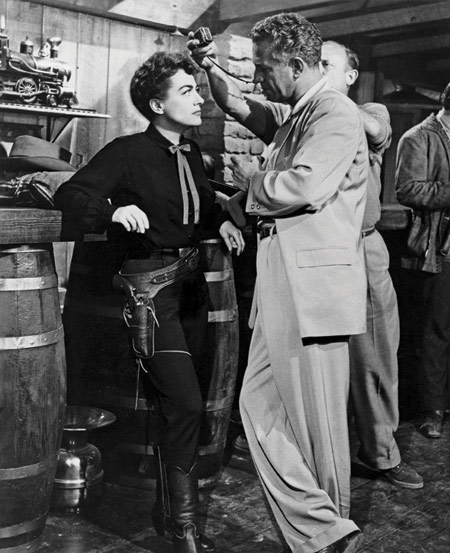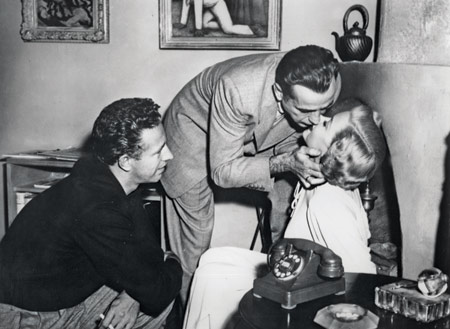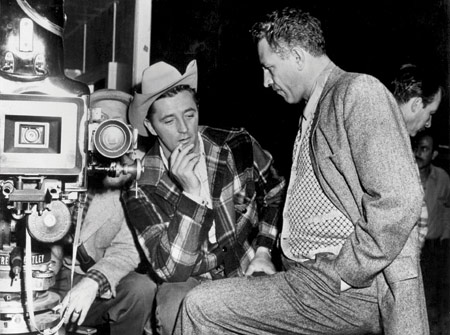BY TERRENCE RAFFERTY

Johnny Guitar (1954)
Nicholas Ray was better at beginnings than endings. His very first film, They Live by Night (1948), opens—after a brief prologue which looks tacked on by the studio—with a startling aerial shot, taken from a helicopter, of an open-topped car streaking through a flat, dusty landscape—a god’s-eye view of men on the lam. The camera tracks the car for nearly a full minute, swooping and hovering, as the viewer, immediately engaged, tries to see how many passengers there are—three, no, four—and what they’re doing with such unseemly urgency. It’s an exhilarating start, both to the movie and to the director’s remarkable, and remarkably strange, career.
The opening shot of Ray’s greatest success, Rebel Without a Cause (1955), is striking, too, yet the only way in which it resembles the helicopter shot of They Live by Night is that both are seen behind the opening credits. In Rebel, there’s just a single human figure, that of the young hero, Jim Stark (James Dean), drunk as a lord and crawling on the sidewalk. The camera’s vantage point is as low as They Live by Night’s is high: as if in sympathy with the protagonist’s low sense of himself, Ray shoots the scene at ground level, from a snake’s-belly angle. They Live by Night is in black-and-white, Rebel Without a Cause in color. And although the earlier film is shot in the then standard Academy ratio (1.37:1) and the latter is in CinemaScope, it’s the opening of Rebel that feels more claustrophobic; by contrast, the speeding jalopy of They Live by Night, in its tighter frame, seems an image of freedom.
Raymond Nicholas Kienzle, who called himself Nicholas Ray, was no stranger to paradoxical effects of that sort. He was a connoisseur of the counterintuitive, which made him for the first decade of his career one of the most bracingly unpredictable directors in American film, and for the 20 largely fallow years that followed a fascinating enigma. Between 1948 and 1958—the year a young French critic named Jean-Luc Godard declared in the pages of Cahiers du Cinéma that “the cinema is Nicholas Ray”—the auteur made 17 movies that bear his name as director (and shot scenes for at least four that don’t). In the next 21 years, he managed to add only four more features to his filmography, one of which, 55 Days at Peking (1963), was completed by another director, Andrew Marton, after Ray quit the film halfway through.

In a Lonely Place (1950)
Among the 17 pictures Ray directed in his peak period, there are some outright clunkers, which shall remain nameless here, and a handful of solid, competent jobs on routine studio assignments: the best of the latter class are a sly melodrama, Born to Be Bad (1950), a tense Western, Run for Cover (1955), and a colorful, weirdly affecting gangster picture, Party Girl (1958). But in that busy first decade he also made a couple of movies—Rebel Without a Cause and Bigger Than Life (1956)—that even now, nearly 60 years later, seem to define the peculiar anxieties and contradictions of America in the ’50s, and a few that in their willingness to explore the more elusive reaches of human behavior transcend sociology altogether.
Rebel Without a Cause, recently made available in a spiffy Blu-ray edition, is maybe the most famous of all teenage angst movies. As adolescent cris de coeurs go, it’s hard to top James Dean wailing “You’re tearing me apart!” to his bickering mom and dad, and although the scene comes early, Ray manages to sustain that near-hysterical pitch throughout. The overwrought drama, and Dean’s red jacket, will always find a place in the hearts of troubled kids, but for us grownups the chief interest of the film today is Ray’s amazingly inventive use of CinemaScope, a ratio that other (especially older) directors were finding problematic. From that opening low angle image on, Ray kept dreaming up ways to make ’Scope framing expressive of something other than mere vastness; to use it in ways that didn’t require the panoramic landscapes of Westerns and biblical epics. In Rebel and Bigger Than Life, both set in the suburbs, the director employs a lot of close-ups and tight two-shots, making the screen’s unnatural shape enhance, rather than detract from, the intimacy of the drama. The presence of Dean in Rebel somehow contributes to this effect: we seem to be seeing all the action through his perpetually narrowed eyes. And in both films, Ray’s framing gives the viewer an aching sense of the characters’ isolation: in CinemaScope, their small worlds look too large for them.
Astonishingly, Rebel Without a Cause was Ray’s first movie in ’Scope; Run for Cover, made earlier that year, was in the less extreme widescreen process VistaVision, and all his previous films were in the Academy ratio. By the time of Bigger Than Life, a domestic horror story about a suburban dad driven round the bend by steroids, he was experimenting with it even more freely, using distorted angles and expressionistic framing to heighten the escalating madness on screen. It’s a terrifying picture. (There’s a beautiful Criterion DVD release of it.) And in the World War II drama Bitter Victory (1957)—the film that prompted Godard’s “cinema is Nicholas Ray” encomium—his mastery of the format seems complete. He moves effortlessly between intimate scenes and the huge, empty landscapes of North Africa; the viewer’s sense of the characters’ size, and the consequentiality of their actions, shifts constantly like the desert sands.

The Lusty Men (1952)
Although none of Ray’s later films were as commercially successful as Rebel Without a Cause, he did become one of the studios’ go-to CinemaScope directors, and for a while he wound up directing the sort of epic pictures that seemed to require his special expertise but in fact did not: his ingenuity wasn’t really needed for the widescreen spectacle of King of Kings (1961) or 55 Days at Peking. No wonder he bailed. Ray was a filmmaker who was easily bored, who did nothing by the book, and was only fully engaged when he was trying out something new. Before he became a movie director, he had worked in several different creative fields, studying with Frank Lloyd Wright for a time, then turning his hand to radio and theater. If there was a constant in his life and his career, it was his restlessness, and that temperamental inability to settle anywhere—a characteristic of many of the people in his films—informed both. He once told a Cahiers interviewer, “I don’t think that any director can assert that his style is the long shot, the medium shot or the close-up, unless he has the mind of a civil servant.” And although the Cahiers crowd always wanted to identify a stylistic “signature” in their pet auteurs, Ray didn’t really have one. He was equally adept at long shots, medium shots, and close-ups. He was proficient at both camera movement and fixed setups, interiors and exteriors, low angles and high, black and white and color. In his editing, he tended to use more dissolves than most Hollywood directors of his time, and that’s perhaps the only consistent quirk in his style—perhaps an indication of his general preference for fluidity over hard, nailed-down meanings. He wasn’t always an improviser, but there’s a sense in all his films, the best and the worst, of an artist who likes to keep his options open.
And although Ray was known as a master of CinemaScope, a surprising number of his most effective pictures are in the old-fashioned Academy ratio. Between They Live by Night and Rebel Without a Cause, he directed a couple of unusually ambitious noirs—In a Lonely Place (1950) and On Dangerous Ground (1951)—which are among his most memorable films, as well as a rodeo picture, The Lusty Men (1952), which was among his own personal favorites. The noirs are completely different from one another. In a Lonely Place, about an angry, possibly homicidal screenwriter played by Humphrey Bogart, is tightly controlled and claustrophobic—almost all interiors. In On Dangerous Ground, about a ruefully brutal cop (Robert Ryan), the action takes place mostly outdoors: in the first half, on the mean streets of the city, in the second half, in a snowy countryside that’s less idyllic than it appears. The films aren’t alike in mood or technique, but they share a sort of searching, tentative quality that renders the films’ mystery plots all but irrelevant: Ray keeps the focus on the ambiguities of his heroes’ volatile temperaments. These movies (both available on good-looking DVDs) are among the sharpest and most melancholy film noirs ever made.
The Lusty Men, which is sadly unavailable on any format, is one of Ray’s most ramshackle pictures; both he and his star, Robert Mitchum, claimed in later years that they were largely making it up as they went along. The rambling nature of the narrative, of course, fits the rodeo-circuit lifestyle perfectly, and because the movie is about the conflict between uncertain freedom and the desire to settle down (Ray always said it was about the yearning to find a home), there’s a built-in tension in the most casual actions and gestures—an electricity even in Mitchum’s lazy walk. In the end, the tension isn’t fully resolved, the desire for home still, in some sense, a matter for debate. Ray, who began his movie career with a story about young fugitives, ended it 25 years later with a free-form mess of images, made with a bunch of his film students, that he called We Can’t Go Home Again (1973). He never did settle down. He stayed on the run, where he belonged.